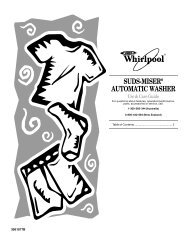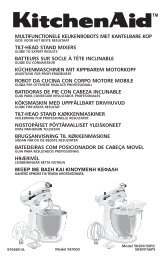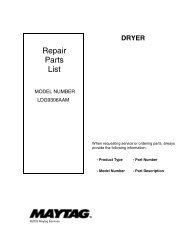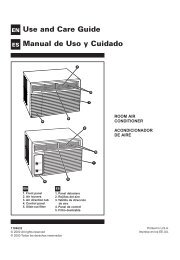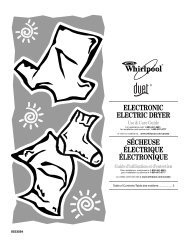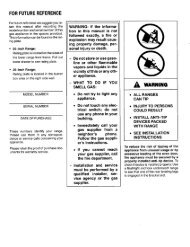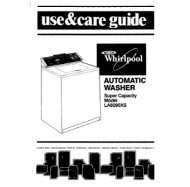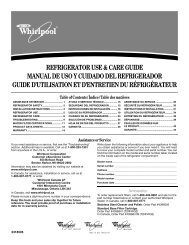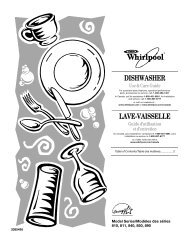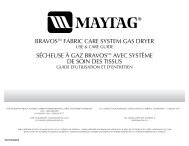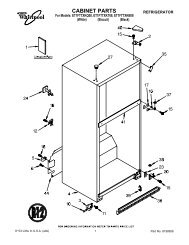refrigerator use & care guide manual de uso y cuidado del ...
refrigerator use & care guide manual de uso y cuidado del ...
refrigerator use & care guide manual de uso y cuidado del ...
Create successful ePaper yourself
Turn your PDF publications into a flip-book with our unique Google optimized e-Paper software.
If a reverse osmosis water filtration system is connected to your<br />
cold water supply, the water pressure to the reverse osmosis<br />
system needs to be a minimum of 40 to 60 psi (276 - 414 kPa).<br />
If the water pressure to the reverse osmosis system is less than<br />
40 to 60 psi (276 - 414 kPa):<br />
■ Check to see whether the sediment filter in the reverse<br />
osmosis system is blocked. Replace the filter if necessary.<br />
■ Allow the storage tank on the reverse osmosis system to refill<br />
after heavy usage.<br />
If you have questions about your water pressure, call a licensed,<br />
qualified plumber.<br />
Connect the Water Supply<br />
Read all directions before you begin.<br />
IMPORTANT: If you turn the <strong>refrigerator</strong> on before the water line is<br />
connected, turn the ice maker OFF.<br />
4<br />
Connect to Water Line<br />
1. Unplug <strong>refrigerator</strong> or disconnect power.<br />
2. Turn OFF main water supply. Turn ON nearest faucet long<br />
enough to clear line of water.<br />
3. Locate a ½" to 1¹⁄₄" (1.25 cm to 3.18 cm) vertical cold water<br />
pipe near the <strong>refrigerator</strong>.<br />
IMPORTANT:<br />
■ Make sure it is a cold water pipe.<br />
■ Horizontal pipe will work, but drill on the top si<strong>de</strong> of the<br />
pipe, not the bottom. This will help keep water away from<br />
the drill and normal sediment from collecting in the valve.<br />
4. Determine the length of copper tubing you need. Measure<br />
from the connection on the lower left rear of <strong>refrigerator</strong> to the<br />
water pipe. Add 7 ft (2.1 m) to allow for cleaning. Use ¹⁄₄"<br />
(6.35 mm) O.D. (outsi<strong>de</strong> diameter) copper tubing. Be sure both<br />
ends of copper tubing are cut square.<br />
5. Using a groun<strong>de</strong>d drill, drill a ¹⁄₄" hole in the cold water pipe<br />
you have selected.<br />
A<br />
G<br />
B<br />
C<br />
F E<br />
A. Cold water pipe<br />
B. Pipe clamp<br />
C. Copper tubing<br />
D. Compression nut<br />
D<br />
E. Compression sleeve<br />
F. Shutoff valve<br />
G. Packing nut<br />
6. Fasten the shutoff valve to the cold water pipe with the pipe<br />
clamp. Be sure the outlet end is solidly in the ¹⁄₄" drilled hole in<br />
the water pipe and that the washer is un<strong>de</strong>r the pipe clamp.<br />
Tighten the packing nut. Tighten the pipe clamp screws slowly<br />
and evenly so washer makes a watertight seal. Do not<br />
overtighten or you may crush the copper tubing.<br />
7. Slip the compression sleeve and compression nut on the<br />
copper tubing as shown. Insert the end of the tubing into the<br />
outlet end squarely as far as it will go. Screw compression nut<br />
onto outlet end with adjustable wrench. Do not overtighten.<br />
8. Place the free end of the tubing in a container or sink, and turn<br />
ON the main water supply. Flush the tubing until water is clear.<br />
Turn OFF the shutoff valve on the water pipe. Coil the copper<br />
tubing.<br />
Connect to Refrigerator<br />
1. Unplug <strong>refrigerator</strong> or disconnect power.<br />
2. Attach the copper tube to the valve inlet using a compression<br />
nut and sleeve as shown. Tighten the compression nut. Do not<br />
overtighten.<br />
3. Use the tube clamp on the back of the <strong>refrigerator</strong> to secure<br />
the tubing to the <strong>refrigerator</strong> as shown. This will help prevent<br />
damage to the tubing when the <strong>refrigerator</strong> is pushed back<br />
against the wall.<br />
4. Turn shutoff valve ON.<br />
5. Check for leaks. Tighten any connections (including<br />
connections at the valve) or nuts that leak.<br />
A. Tube clamp<br />
B. Copper tubing<br />
6. The ice maker is equipped with a built-in water strainer. If your<br />
water conditions require a second water strainer, install it in<br />
the ¹⁄₄" (6.35 mm) water line at either tube connection. Obtain<br />
a water strainer from your nearest appliance <strong>de</strong>aler.<br />
Complete the Installation<br />
C. Compression nut<br />
D. Valve inlet<br />
Electrical Shock Hazard<br />
Plug into a groun<strong>de</strong>d 3 prong outlet.<br />
Do not remove ground prong.<br />
Do not <strong>use</strong> an adapter.<br />
Do not <strong>use</strong> an extension cord.<br />
Failure to follow these instructions can result in <strong>de</strong>ath,<br />
fire, or electrical shock.<br />
Plug in <strong>refrigerator</strong> or reconnect power.<br />
NOTE: Allow 24 hours to produce the first batch of ice. Discard<br />
the first three batches of ice produced. Allow 3 days to completely<br />
fill ice container.<br />
Refrigerator Doors<br />
TOOLS NEEDED: ⁵⁄₁₆" hex-head socket wrench, #2 Phillips<br />
screwdriver, flat-bla<strong>de</strong> screwdriver, ⁵⁄₁₆" open-end wrench, flat 2"<br />
putty knife.<br />
IMPORTANT:<br />
■ Unplug <strong>refrigerator</strong> or disconnect power.<br />
■ Remove food and adjustable door or utility bins from doors.<br />
■ If you only want to remove and replace the doors, see<br />
“Remove Doors and Hinges” and “Replace Doors and<br />
Hinges.”<br />
A<br />
B<br />
C<br />
D<br />
WARNING



